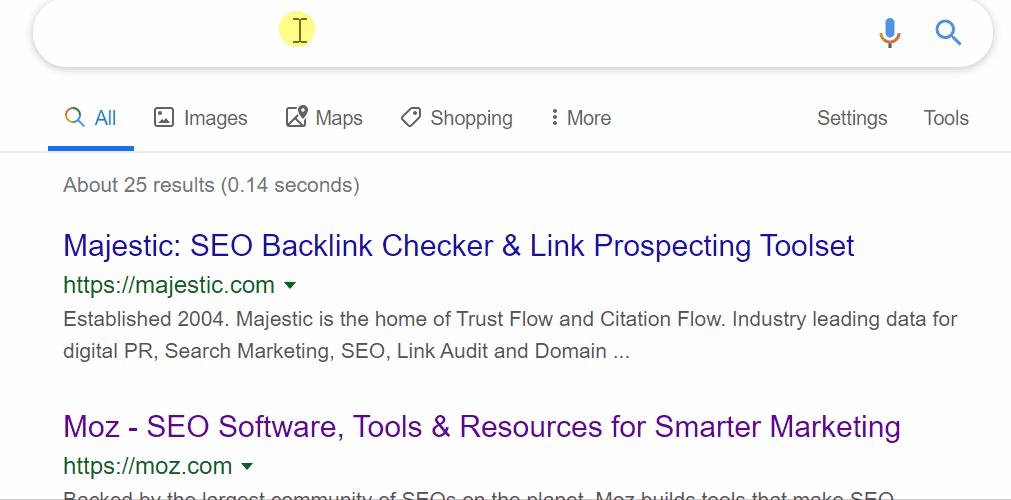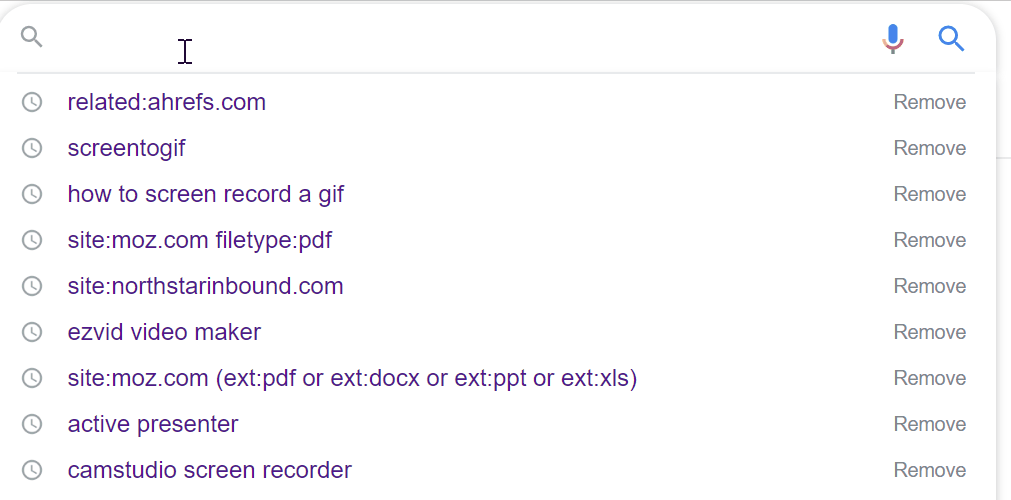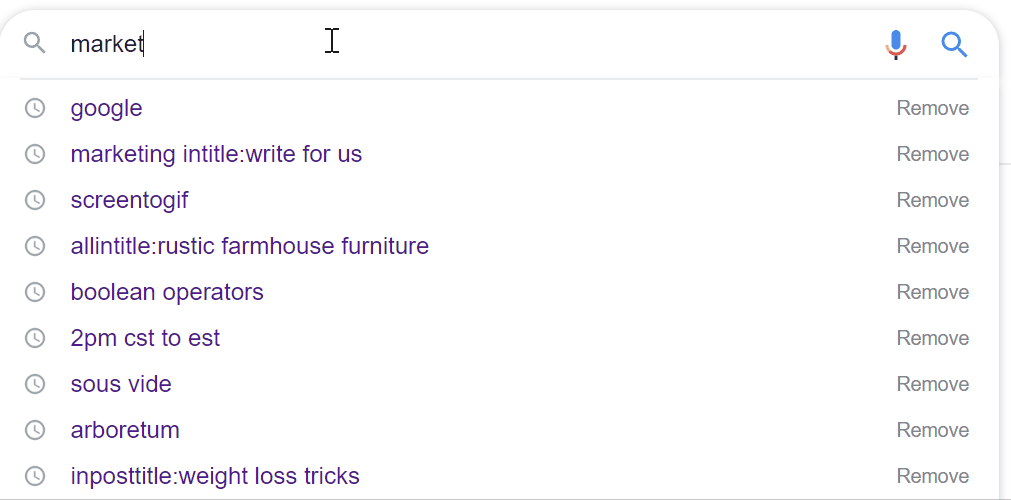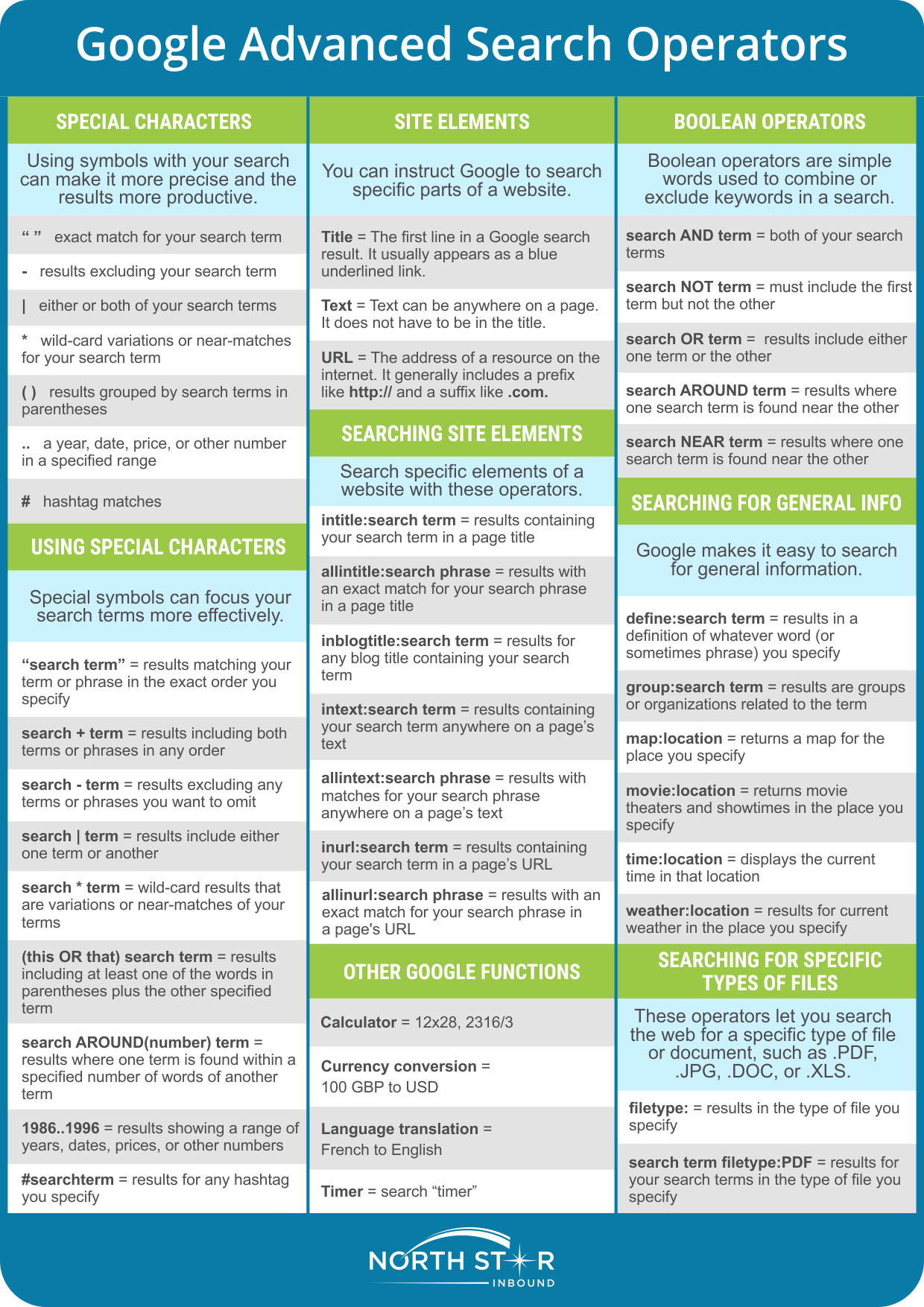Table of Contents
Have you ever wanted to find out how often your competitors are publishing content? Or what about finding hundreds of sites that have linked to your competitors and not you?
In this post, we’re going to share 20 Google advanced search operator tips and tricks you can use to work more efficiently and become a Google search samurai.
Sometimes they’re referred to as Google search commands – other people call ‘em Google search shortcuts and others even call them Google search parameters.

One thing we call them? AWESOME.
And it looks like everybody’s fav doctor, Dr. Pete from Moz, loves them too.
Why? Because Google advanced search operators are an incredibly powerful way to ensure that your queries return pinpoint, highly focused results.
This helps you perform your job more efficiently by narrowing and fine-tuning results, trimming the fat and not letting any noise distract you from what you’re looking for or researching.

Google search operators can do everything from finding qualified keywords fast; to finding your direct competitors; to even hunting down plagiarized content.
Pretty awesome, right?
Here’s a sneak peek at the 20 advanced search tips you’ll be learning today:
- Find duplicate or plagiarized content
- Find direct competitors
- Find out how Google categorizes your site
- Find indexing errors
- Find unwanted files and pages
- Find citations to your competitors that you don’t have
- Find guest post opportunities
- Find resource page opportunities
- Find internal linking opportunities
- Find pages that contain certain keywords
- Find internal duplicate content
- Find original research and case studies on a certain topic
- Find out how often your competitors are publishing new content
- Find Q&A threads related to your content
- Find out if your domain name was registered somewhere else
- Quickly check the competitiveness of a long-tail keyword
- Exclude specific terms that aren’t helpful to you
- Find a non-https site
- Find competitor backlinks
- Find social profiles for outreach
But before we talk about those hyper-focused search operators and commands, let’s make sure you understand the basics.

Note: Don’t put spaces between the symbol or word operator and your search term. For example, a search for site:northstarinbound.com will work, but site: northstarinbound.com won’t.
Google Basic Search Operators
|
“ “ |
Force the search to look for your exact phrase rather than adding synonyms or other factors you aren’t interested in. Like this: “inbound marketing” |
|
| |
Identical to using OR, which tells Google that the words can be used interchangeably, giving you results for X or Y or both. Like this: bagels new york | los angeles |
|
( ) |
Group words or operators together to control the search results. Like this: marketing agency (new york OR los angeles) |
|
– |
Exclude a word or phrase. Like this: blue jays -toronto |
|
* |
Acts as a wildcard and tells Google to “fill in the blank,” returning results for any word. Like this: link * building |
|
#..# |
Search for a range of numbers, like between two dates. Like this: names of us presidents 1790..1850 |
|
$ |
Search for prices. Also works for Euro (€), but not GBP (£). Like this: airpods $50 |
|
in/to |
Convert from one unit to another, like temperature, lbs, time zones, etc. Like this: 2pm cst to est |
Google Advanced Search Operators
|
intitle: |
Find a page with a certain word (or words) in the title. Like this: intitle:potatoes |
|
allintitle: |
Similar to intitle, but this one will only return results with all of the words that you specify included. Great for filtering out results when Google does its own thing. Like this: allintitle:roasted potatoes |
|
inpostitle: |
When conducting research for a blog post, you can search for blogs with specific words in the title. Like this: inpostitle:weight loss tricks |
|
inurl: |
Find a URL with a certain word (or words) in the title. Like this: inurl:potatoes |
|
allinurl: |
Similar to inurl, but this one will only return results with all of the words that you specify included. Like this: allinurl:roasted potatoes |
|
intext: |
Find pages with a certain word (or words) within the content. Like this: intext:potatoes |
|
allintext: |
Similar to intext, but this one will only return results with all of the words that you specify included. Like this: allintext:roasted potatoes |
|
filetype: |
Filter results to get only a certain file type. Ex: PDF, DOC, PPT, etc. Like this: moz filetype:PDF |
|
ext: |
Works exactly the same way as filetype: Like this: moz ext:PDF |
|
related: |
Find sites related to a domain. Great when looking for competitors or shopping for similar companies/products. Like this: related:ahrefs.com |
|
AROUND(X): |
This is a proximity search to find two or more words within a designated number of words from each other. Like this: austin AROUND(2) texas |
|
site: |
Filter results down to only a specific website. Like this: site:northstarinbound.com |
|
define: |
Move over, Webster’s. Google has a built-in dictionary. Find the definition of a word in seconds. Like this: define:marketing |
|
cache: |
Find the most recent cached version of a website. Like this: cache:moz.com |
|
weather: |
Find the weather for a specific location. Like this: weather:austin, texas |
|
map: |
Find map results for a specific location. Like this: map:austin, texas |
|
movie: |
Find information about a specific movie. If it’s currently out, it can even return showtimes. Like this: movie:titanic |
Boolean Operators
Boolean logic, fondly named after mathematician George Boole, is a system of logic whose purpose is to help produce optimum results. When the Boolean Operators are used in search, they help you string together a logical query. Think of them as simple words used as conjunctions to tell Google which words you’d like to combine or exclude in your returns.
Note: You MUST use ALL CAPS when using Boolean Operators.
|
AND |
AND tells Google that you’d like results for both X and Y. Like this: french fries AND roasted potatoes |
|
OR |
OR tells Google that the words can be used interchangeably, giving you results for X or Y or both. Like this: french fries OR roasted potatoes |
|
NOT |
NOT tells Google that you’d like results for X, but not Y. Like this: french fries NOT roasted potatoes |
Google Search Operators that No Longer Work
|
~ |
The tilde operator was once used to help searchers find synonyms of a keyword. Today Google does that automatically. |
|
+ |
This was used to force an exact match on a single keyword or phrase. Today, you can use the “double quotes” operator to do this. |
|
daterange: |
This was used to find results from a specific date range, but it doesn’t seem to work. |
|
link: |
This was once used to find pages linking to a specific domain. Google discontinued this in 2017. |
|
inanchor: |
This was once used to find inbound links to an article using specific anchor text. |
|
phonebook: |
This was once used to search for a person’s phone number. |
20 Google Search Operators Tips & Hacks for SEO
1. Find duplicate or plagiarized content on an external site
Duped content is a problem for way more than e-commerce sites. If you have a blog, whether it’s heavy on words or photos, then your work can be vulnerable to plagiarism, too. It’s common for people to steal and reprint an author’s words without attribution — and often without the originator knowing it. That’s why it’s a good idea to monitor your search results regularly.
The intitle: operator is a good place to start searching for plagiarized content, along with an exact-match phrase from your site heading or a blog post title:
intitle:“exact-match phrase” -site:yourdomain.com
Remember to exclude your own site in this search: Use the -site: operator combo, or your own original content will appear among the results.
NOTE: If you do find your work duplicated on someone else’s page, check first to see whether they’ve attributed or linked back to you, even if you don’t remember getting contacted for permission to reuse the content. If you find your work has been used without your permission or attribution, then follow these steps to have your stolen content taken down off the offending site.
2. Find direct competitors
There are a couple of ways you can find direct competitors using Google search operators. One is useful if you’re an eCommerce site selling specific products. You can use the allintitle: operator to find other sites that sell the same things. For example, if you sold rustic farmhouse furniture, you could search for other sites that use that same description in their titles:
allintitle:rustic farmhouse furniture
And in doing so, it looks like you’ll find you have a bunch of competition:

Another way to find competitors is to use the related: operator to find other websites that Google sees as similar to yours. This is helpful for a few reasons, like also understanding how Google categorizes your site (the next item on this list).
related:ahrefs.com
3. Find out how Google categorizes your site
It’s important to know how Google categorizes your site among your colleagues and competitors. Let’s use the related: operator to see if ahrefs.com is related in Google’s eyes to their competitors:
related:ahrefs.com
Once you search for the above, you can see all the results of sites Google feels are related to your search, like this:

We can see that Google has correctly categorized ahrefs.com, since the related: results return direct competitors.
4. Find indexation errors
Most websites contain SEO and Google indexation errors; it’s an internet fact. According to SpyFu.com, a recent study found that, within the content of 175 million websites,300 million SEO errors were identified.
How does the indexing for your site stack up? Maybe a page has been indexed when it shouldn’t be — or vice-versa: A page needs to be indexed, but isn’t. Again, start with the site: operator to see how your site indexing stacks up:
site:northstarinbound.com

If you find some odd pages indexed that you don’t want, remove them from the search engine results by no-indexing them.
Next try narrowing the search to certain subdomains using a combination of the site: operator and the * operator like this:
site:*.northstarinbound.com -www
This subdomain search is especially useful to find, for example, pages that return a 404 error and shouldn’t be indexed.
Here are a few other ways to uncover indexing errors with Google operators:
site:northstarinbound.com/category
If your blog is hosted via WordPress, this lets you find the category pages that are indexed.
And if you’re looking for the tags on your blog posts, this search will let you find all your WordPress tag pages that are indexed:
site:northstarinbound.com inurl:tag
5. Find files and pages
Especially as your website grows, it can be hard to keep track of all its elements — and easy to forget about old files you may have uploaded, like text files, Word documents, photo slideshows, PDFs, PowerPoint presentations, etc. Stray documentation left around your site can inadvertently get picked up and indexed by Google, muddying your site profile and knocking down your results for the pages you want to rank. Combine the site: and filetype: or ext: operators to find unwanted extra files and check their legitimacy. When combined, it looks like this:
site:moz.com filetype:PDF

site:moz.com (ext:PDF OR ext:docx OR ext:ppt OR ext:xls)
Note: The filetype: and ext: operators also work with files like .asp, .php, .html, and similar types. It’s important to delete or no-index these files or pages if you don’t want visitors to find them.
Exclude the robots
You know that the itty bitty robots.txt file imposes an outsize importance on your search engine rankings, right? That’s because it’s the file that tells web robots (aka search engines) which pages to crawl — and which not to crawl. You want to set up your robots.txt file perfectly, then leave it alone to do its job.
Many other text files, though, may have been accidentally left live on a site and are now just sitting around taking up space. Use Google to find extraneous text files with a search that excludes your robots file:
site:northstarinbound.com filetype:txt -inurl.robots.txt
Once you find the text files and pages you don’t want people to see, you can no-index them while remaining sure that your all-important robots.txt file is intact.
6. Find links to your competitors that you don’t have
Although the link: operator has been deprecated, it still works from time to time, so it’s worth giving it a shot.
Note: Make sure when searching for links to your competitor, you exclude their own site using the – operator in combination with the site: operator.
link:moz.com/blog -site:moz.com

7. Find guest post opportunities
Guest posting is a great way for you to get your company and voice seen in other places. Not every company or blog allows for guest posting, however, so it’s a good idea to narrow your search to ensure that you’re reaching out only to those that would consider taking you.
In order to do that, it’s a good idea to jot down the kinds of wording that a guest post opportunity page might contain, like:
- Write for us
- Write for our blog
- Become a contributor
- Guest post guidelines
After you have that, you can either search for one specific phrase using the intitle: operator, like this (making sure to include the industry):
marketing intitle:write for us

Or you can look for a few phrases at once, utilizing the | or OR operator.
marketing intitle:write for us | intitle: become a contributor | intitle:guest post guidelines
8. Find resource page opportunities
If you’re looking to get your resource onto a resource site (a page that typically links to varying resources or tools for a given topic), you can use the intitle: operator to assist.
marketing intitle:resources
9. Find internal linking opportunities
Internal links help with your site’s architecture, but they also guide your visitor to logical other pages or resources within your site. It’s important to have relevant links connecting complementary pages in order to keep building rapport and nurturing your potential leads.
It’s also amazing for SEO when properly and intelligently used.
For example, if you recently published a blog post about link building tips, wouldn’t it make sense to link your other blog posts that discuss link building to that page?
Rather than scouring through your long list of published posts, utilizing the site: , – and intext: operators will help you hunt down these opportunities. Like this:
site:northstarinbound.com -site:northstarinbound.com/seo-tools-238-tools-link-building-seo-keyword-research/ intext:link building
What this did was:
- Force Google to only show results specific to northstarinbound.com
- Ensure that the page we want to build links to is omitted from the search
- Show pages that have “link building” (or link | building) within the body copy
After doing this, you can see that the search delivered about 18 results, like this one:

What a quick and easy way to find an opportunity to link to the page we’re looking to build internal links to!
10. Find pages that contain certain keywords
By using the intext: operator, you can find pages across the web, or for a specific site, that contains certain keywords.
site:searchengineland.com intext:link building tools 202S
11. Find internal duplicate content
The widespread problem of duplicate content has different implications, depending on where it’s found and what form it takes: If content is repeated within a single site, it’s likely due to an indexing issue arising from pagination errors, citation repeats, multiple product pages, or other inadvertent repetitions.
Page duplication, or double-indexing, is a common problem for site developers. Among 300,000 indexing errors found in the aforementioned study, almost 10% were issues with duplicate content or canonical tags.
You want your site index to be clean and free from duplicate content. To help you determine if you have any, turn once again to the site: operator for help, searching for content that often gets duplicated across a single website.
site:northstarinbound.com “link building”
Going further, you can combine site: with intitle: followed by an exact match phrase to find pages on a site that may be exact duplicates.
site:northstarinbound.com intitle:link building tools

If you sell merchandise of any type, it’s much easier to encounter duplicates on your own site. Anyone who’s done comparison shopping online knows that brand descriptions are often lifted in their entirety from one site and used on multiple others. Common copying culprits include:
- Product descriptions (especially ones written in third person)
- Long calls to action with short unique content on various pages
- Similar or identical products with different quantity counts
- Product review pages
In this last case, it’s also likely that many results will be for pages where the URL contains either “review” or “reviews.” So build on the previous search by adding those exclusions for review pages:
site:northstarinbound.com “link building” -inurl:review -inurl:reviews
12. Find original research and case studies on a certain topic
Looking to find some original research on a specific topic you’re writing a piece on? You can use the filetype: operator to find case studies, research papers and statistics based on a certain topic.
link building filetype:PDF

13. Find out how often your competitors are publishing new content
Interested in seeing how often your competition is publishing new content to their sites? Using the site: operator (have you noticed yet how useful this operator is? ?), you can see how many pieces have been published to a competitor’s blog.
*Note: Most blogs live on their own subdomain, separate from the main site. Make sure you’re using the correct url when doing your research. It’ll typically look something like this: moz.com/blog
site:moz.com/blog

Here we can see that the Moz blog had close to 7,500 blog posts. Now we want to see exactly how often they’re actually publishing.
We can do this by using Google’s built-in time period tool since the daterange: operator has been deprecated.
Tools > Any time > Select time period

Once we look at how many pieces have been published within the past month, we see that Moz publishes approximately 12 pieces per month.
14. Find Q&A threads related to your content
If contributing value to forums is part of your amplification strategy, google search operators can help you move even faster when looking for which questions to address.
You can use the site: and intitle: operators to get specific. Like this:
site:quora.com intitle:link building

This simple search gives you almost 5,000 opportunities to contribute value to a user’s question, while also adding a link back to your content.
15. Find out if your domain name was registered somewhere else
If content appears in identical form across multiple sites with no citation attributing it to the original creator, it’s likely a case of theft. This can show up as identical copy across several pages, or in the form of alternate top-level domains (TLDs), where a site shares your domain name but bears a different top-level domain, like a .edu instead of your registered .com.
Combining the site: operator with the * wildcard and excluding – the original site, this search can reveal any sites bearing the same domain name but a different TLD from your own.
site:northstarinbound.com* -site:northstarinbound.com
16. Check the competitiveness of a keyword
If you’re in the middle of a Google search to research some keywords, you can get a quick idea of how targeted a long-tail keyword is by using the allintitle: operator.
allintitle:link building strategies 2020

For example, if you were to check out how many pages are targeting “link building strategies 2020”, you can already see that 259 sites have updated their pieces to be the most date-relevant.
17. Exclude specific terms
Perhaps you’re conducting research for a piece about inbound marketing, but you don’t want to read tons of articles about HubSpot. You can easily remove HubSpot from your search by utilizing the – operator.
inbound marketing -hubspot

18. Find a non-https site
Secure pages are a necessity these days, but if you’re in the market to see if a site has any non-secure ones, you can find out using a combo of the site: , – , and inurl: operators.
site:macys.com -inurl:https

19. Find competitor backlinks
You can also string together search operators to find your sites that link to your competitors but don’t link to you. You can do this by combining the intext: operator while excluding your competitor’s own site using the – operator.
intext:moz -site:moz.com
20. Find social profiles for outreach
If you’d like to reach out to a particular person, whether to get a quote or because you’ve mentioned them within your piece, you can use the site: and OR/| operators to find their social profiles.
rand fishkin (site:twitter.com | site:facebook.com | site:linkedin.com)

And within 0.58 seconds, we have all three of Rand’s social media profiles.
The number of Google advanced search operators can seem overwhelming, as can the breadth and variety of their uses. But don’t be discouraged! They can make your life easier and more enjoyable. Take your time to dig into them one by one as you identify a need for them, and – with the help of our handy cheat sheet – see how much more effective and functional your online experience can be.

Share this Image On Your Site





